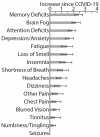Cortical GABA Levels Are Reduced in Post-Acute COVID-19 Syndrome
- PMID: 38137114
- PMCID: PMC10741691
- DOI: 10.3390/brainsci13121666
Cortical GABA Levels Are Reduced in Post-Acute COVID-19 Syndrome
Abstract
After recovering from the acute COVID-19 illness, a substantial proportion of people continue experiencing post-acute sequelae of COVID-19 (PASC), also termed "long COVID". Their quality of life is adversely impacted by persistent cognitive dysfunction and affective distress, but the underlying neural mechanisms are poorly understood. The present study recruited a group of mostly young, previously healthy adults (24.4 ± 5.2 years of age) who experienced PASC for almost 6 months following a mild acute COVID-19 illness. Confirming prior evidence, they reported noticeable memory and attention deficits, brain fog, depression/anxiety, fatigue, and other symptoms potentially suggestive of excitation/inhibition imbalance. Proton magnetic resonance spectroscopy (1H-MRS) was used to examine the neurochemical aspects of cell signaling with an emphasis on GABA levels in the occipital cortex. The PASC participants were compared to a control (CNT) group matched in demographics, intelligence, and an array of other variables. Controlling for tissue composition, biological sex, and alcohol intake, the PASC group had lower GABA+/water than CNT, which correlated with depression and poor sleep quality. The mediation analysis revealed that the impact of PASC on depression was partly mediated by lower GABA+/water, indicative of cortical hyperexcitability as an underlying mechanism. In addition, N-acetylaspartate (NAA) tended to be lower in the PASC group, possibly suggesting compromised neuronal integrity. Persistent neuroinflammation may contribute to the pathogenesis of PASC-related neurocognitive dysfunction.
Keywords: 1H-MRS; GABA; NAA; anxiety; cognitive deficits; depression; excitation/inhibition balance; insomnia; long COVID; magnetic resonance spectroscopy.
Conflict of interest statement
The authors declare no conflict of interest. The funders had no role in the design of the study; in the collection, analyses, or interpretation of data; in the writing of the manuscript; or in the decision to publish the results.
Figures






Similar articles
-
Cytokines (IL1β, IL6, TNFα) and serum cortisol levels may not constitute reliable biomarkers to identify individuals with post-acute sequelae of COVID-19.Ther Adv Neurol Disord. 2024 Feb 12;17:17562864241229567. doi: 10.1177/17562864241229567. eCollection 2024. Ther Adv Neurol Disord. 2024. PMID: 38348267 Free PMC article.
-
Impact of sleep disruption on cognitive function in patients with postacute sequelae of SARS-CoV-2 infection: initial findings from a Neuro-COVID-19 clinic.Sleep Adv. 2024 Jan 12;5(1):zpae002. doi: 10.1093/sleepadvances/zpae002. eCollection 2024. Sleep Adv. 2024. PMID: 38370438 Free PMC article.
-
Cortical GABA levels are reduced in young adult binge drinkers: Association with recent alcohol consumption and sex.Neuroimage Clin. 2022;35:103091. doi: 10.1016/j.nicl.2022.103091. Epub 2022 Jun 20. Neuroimage Clin. 2022. PMID: 35753236 Free PMC article.
-
Neurological post-acute sequelae of SARS-CoV-2 infection.Psychiatry Clin Neurosci. 2023 Feb;77(2):72-83. doi: 10.1111/pcn.13481. Epub 2022 Oct 17. Psychiatry Clin Neurosci. 2023. PMID: 36148558 Free PMC article. Review.
-
Short-term and Long-term Rates of Postacute Sequelae of SARS-CoV-2 Infection: A Systematic Review.JAMA Netw Open. 2021 Oct 1;4(10):e2128568. doi: 10.1001/jamanetworkopen.2021.28568. JAMA Netw Open. 2021. PMID: 34643720 Free PMC article.
Cited by
-
Neuroimmune pathophysiology of long COVID.Psychiatry Clin Neurosci. 2025 Jun 19:10.1111/pcn.13855. doi: 10.1111/pcn.13855. Online ahead of print. Psychiatry Clin Neurosci. 2025. PMID: 40536011 Free PMC article.
-
Psychological factors associated with Long COVID: a systematic review and meta-analysis.EClinicalMedicine. 2024 Jul 26;74:102756. doi: 10.1016/j.eclinm.2024.102756. eCollection 2024 Aug. EClinicalMedicine. 2024. PMID: 39764180 Free PMC article.
-
Altered auditory brainstem responses are post-acute sequela of SARS-CoV-2 (PASC).Sci Rep. 2025 Mar 18;15(1):9387. doi: 10.1038/s41598-025-93664-4. Sci Rep. 2025. PMID: 40102496 Free PMC article.
-
A digital intervention for cognitive deficits following COVID-19: a randomized clinical trial.Neuropsychopharmacology. 2024 Dec;50(2):472-479. doi: 10.1038/s41386-024-01995-z. Epub 2024 Oct 2. Neuropsychopharmacology. 2024. PMID: 39358543 Clinical Trial.
References
-
- CDC Long COVID or Post-COVID Conditions. [(accessed on 3 August 2023)]; Available online: https://www.cdc.gov/coronavirus/2019-ncov/long-term-effects/index.html.
-
- DHHS . National Research Action Plan on Long COVID. Office of the Assistant Secretary for Health; Washington, DC, USA: 2022.
Grants and funding
LinkOut - more resources
Full Text Sources

